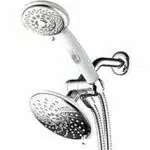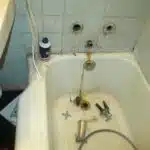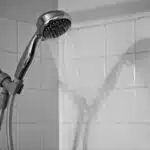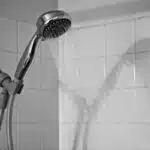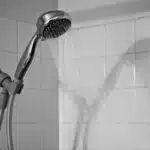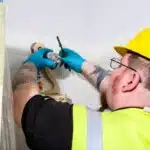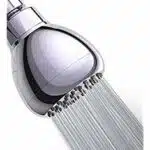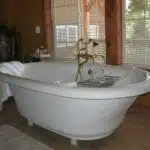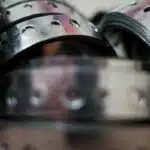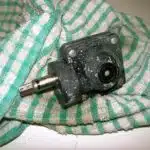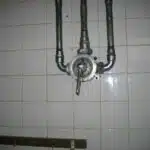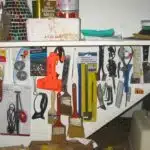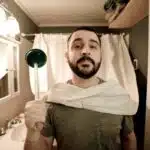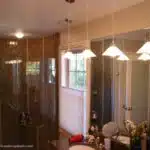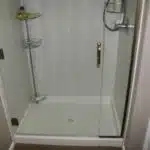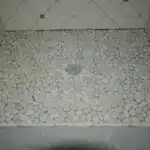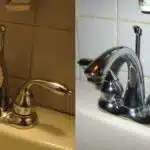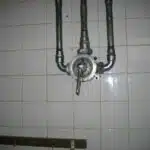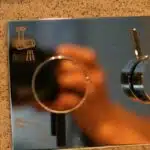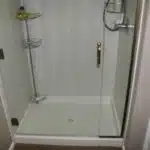As a plumbing expert, I understand the importance of maintaining a functional and efficient shower system. A wall-mounted showerhead is an essential component of any bathroom and can provide a refreshing and enjoyable showering experience. However, over time, these fixtures may become outdated or damaged, requiring replacement.
In this article, I will provide a step-by-step guide on how to replace a wall-mounted showerhead. Whether you are experiencing leaks or simply want to upgrade your bathroom’s style, this process can be done easily with the right tools and knowledge. By following these instructions, you can save money on plumbing services and feel confident in your ability to serve yourself and others in your home.
Assessing The Condition Of Your Current Showerhead
As a plumbing expert, it is important to assess the condition of your current showerhead before attempting to replace it. Doing so will ensure that you choose an appropriate replacement and avoid any potential issues during installation. Assessing showerhead quality involves inspecting for any signs of wear and tear, such as leaks or clogs, as well as checking for any damage to the fixture itself.
One option for upgrading your shower experience is by replacing your traditional wall-mounted showerhead with a handheld one. A handheld showerhead provides more flexibility in directing water flow, making it easier to rinse shampoo out of your hair or wash hard-to-reach areas of your body. Additionally, they are typically more efficient in water usage than traditional showerheads, which can help reduce your water bill.
When assessing the condition of your current showerhead, take note of its make and model as well as any specific features you may want in a replacement. This information will be helpful when choosing a new showerhead that meets both your preferences and practical needs. By taking the time to assess your current setup and consider all options available to you, you’ll be able to find the perfect replacement that suits both your lifestyle and budget.
Choosing A New Showerhead
- There are multiple types of showerheads available, including handheld, wall-mounted, and ceiling-mounted models.
- When replacing a wall-mounted showerhead, it is important to consider the type of connection and the compatibility of the existing fixtures.
- Installing a new showerhead requires turning off the water supply, draining the line, and ensuring that the new showerhead is securely in place.
- Additionally, any additional components such as hoses, valves, or mounting brackets must be properly installed before turning the water supply back on.
Types Of Showerheads
When choosing a new showerhead, it is important to consider the various types available in the market. Different showerheads offer different benefits, and each type caters to varying preferences. Some of the common types include rain showerheads, handheld showerheads, and wall-mounted showerheads.
Rain showerheads are ideal for those who want a luxurious spa-like experience in their own bathrooms. These types of showerheads come in different finishes such as chrome or brushed nickel, which can enhance the aesthetic appeal of your bathroom. On the other hand, handheld showerheads are perfect for those who want more flexibility when washing their hair or cleaning their bodies. They are also great for households with children or pets as they make it easier to rinse them off during bath time. Lastly, wall-mounted showerheads are the most traditional type and they provide a consistent water flow that can be adjusted according to personal preference.
While all these types have their own benefits, adjustable showerheads offer added convenience and practicality. With an adjustable showerhead, you can easily switch between different water flow patterns like rainfall or massage spray. This feature allows you to customize your bathing experience according to your mood or specific needs. Moreover, adjustable showerheads can help you save on water bills as they allow you to control the amount of water that flows out while you bathe.
In conclusion, choosing a new showerhead requires careful consideration of various factors such as personal preference and budget constraints. By understanding the different types available such as rain showerheads, handheld showerheads, and wall-mounted showerheads along with their benefits like adjustable settings and finishes; homeowners can make an informed decision about what will best suit their needs while serving others in their family’s hygiene experience at home.
Installation Process
When it comes to choosing a new showerhead, the installation process is an important consideration. Before making any purchase, homeowners should assess their current plumbing system to determine compatibility with the showerhead they want. This involves checking the size and type of their existing shower arm and valve. It’s also important to ensure that the water pressure in their home is sufficient for the new showerhead.
Once compatibility has been assessed, homeowners can proceed with the installation process. Most showerheads come with detailed instructions on how to install them, but if you’re unsure or encounter any issues during installation, it may be best to consult a plumber. Troubleshooting issues such as leaks or inconsistent water flow can be frustrating and time-consuming, so seeking professional help can save you from unnecessary stress.
In summary, assessing compatibility and properly installing a new showerhead are crucial steps in ensuring a successful bathroom upgrade. While it may seem daunting at first, taking the time to research and plan ahead can make all the difference in achieving your desired bathing experience. Remember that seeking professional assistance when needed is always an option and can prevent any potential setbacks during installation.
Gathering The Necessary Tools And Materials
After choosing the perfect showerhead for your bathroom, it’s now time to gather the necessary tools and materials for replacing your old wall-mounted showerhead. Before starting any work, make sure to turn off the water supply to avoid any accidents or water damage. The tools needed for this project are adjustable wrenches, pliers, Teflon tape, a bucket, and a rag.
Now that you have all the necessary tools and materials, it’s time to begin replacing your old showerhead. First, use an adjustable wrench to loosen and remove the old showerhead from the wall. Make sure to wrap a rag around the shower arm before using the wrench to prevent any scratches or damage. Once removed, clean any debris or old Teflon tape from the shower arm with a bucket of warm soapy water.
Next, apply new Teflon tape onto the threads of the shower arm in a clockwise direction. This will create a tight seal when installing your new showerhead. Screw on your new showerhead by hand until snug and then use pliers or an adjustable wrench to tighten it further (but not too tight!). Now that you know how to replace a wall-mounted showerhead yourself, where to buy one? Many home improvement stores offer different options at varying price points. Do some cost comparison ahead of time so you can make an informed decision based on both quality and price.
Before moving onto installing your new showerhead, it’s important to turn off the water supply first. This will prevent any accidental water leakage while working on your project. Locate your home’s main water valve and turn it off completely before beginning any plumbing work in order to ensure safety during installation process.
Turning Off The Water Supply
To successfully replace a wall-mounted showerhead, it is essential to turn off the water supply properly. Shutting off the water supply will prevent any potential leaks or water damage during the replacement process. Therefore, it is crucial to ensure that you have turned off the correct valve.
To turn off the water supply for plumbing projects, locate the main shut-off valve in your home. This valve is usually located near your water meter and may require a wrench to turn it off fully. If you are unsure about which valve to shut off, consult with a professional plumber for assistance.
Tips for preventing water damage during water supply shut off include checking all faucets and fixtures in your home after shutting off the main valve to ensure there is no residual water left in the pipes. Additionally, placing towels around any exposed pipes can help absorb any remaining water that may leak out during your plumbing project.
When you have successfully turned off the water supply and taken necessary precautions to prevent potential damage, you can move on to removing the old showerhead without worrying about any unwanted leaks or messes.
Removing The Old Showerhead
- Prior to replacing a wall-mounted showerhead, the water supply must be turned off at the main shutoff valve.
- The existing showerhead should be unscrewed and removed from the wall.
- If the old showerhead is stuck or won’t come loose, a wrench or pliers can be used to gently turn it in a counterclockwise direction.
- After the showerhead is removed, any old plumber’s tape should be taken off the pipe threads.
- The new showerhead should be installed and tightened with a wrench, but care should be taken to not overtighten.
- Finally, the water supply should be turned back on and the connection should be checked for any potential leaks.
Turn Off Water Supply
To properly remove an old showerhead, it is essential to turn off the water supply first. This step ensures that there is no water pressure within the plumbing system, which can lead to unwanted leaks and damage. Turning off the water supply also prevents accidental water flow during the removal process, which can cause a messy and time-consuming cleanup. As a plumbing expert, I highly recommend that you take this step seriously and ensure that you know how to properly turn off the water supply before proceeding with replacing your wall-mounted showerhead.
One common mistake people make when turning off the water supply is not knowing where the valve is located. Depending on your home’s plumbing layout, the valve may be in a different location than you expect, such as near the main shutoff or in a utility room. Therefore, it is crucial to locate the valve before attempting to turn it off. Another mistake people make is turning off the wrong valve or not fully closing it, resulting in residual water remaining in the pipes. To avoid these mistakes, familiarize yourself with your home’s plumbing system and double-check that you have correctly turned off the correct valve.
In conclusion, removing an old showerhead requires proper preparation and execution to avoid potential issues down the line. Turning off the water supply is a crucial step in this process and should never be overlooked or rushed through. Knowing how to properly turn off the water supply and avoiding common mistakes will help ensure a smooth replacement process for your wall-mounted showerhead. Remember: taking care of your home’s plumbing system not only benefits you but also serves those around you by preventing potential water damage or leaks that could affect others’ living spaces as well.
Remove Existing Showerhead
Before you can replace your wall-mounted showerhead, you must first remove the existing one. This task may seem straightforward, but it requires careful attention to detail to avoid damaging the plumbing system or causing leaks. As a plumbing expert, I recommend assessing compatibility between the new and old showerheads before attempting to remove the existing one. This step ensures that the replacement process will go smoothly without any unexpected issues.
Once you have determined that the new showerhead is compatible with your current plumbing system, it’s time to begin removing the old one. Start by using a pair of pliers or an adjustable wrench to unscrew the showerhead from its mounting bracket. Be sure to hold onto the arm firmly while turning the showerhead counterclockwise to prevent any damage to the plumbing system. If you encounter resistance during this step, try using a penetrating oil spray to loosen any stubborn connections.
If you encounter any issues during the removal process, it’s essential to troubleshoot them immediately before proceeding further. For example, if you notice that water is leaking from around the arm or mounting bracket, turn off the water supply and assess for any cracks or damage in these areas. Additionally, check that all connections are tight and secure before proceeding with installing a new showerhead. By taking these steps and being diligent in your approach, you can remove an old showerhead safely and efficiently without causing any damage or leaks in your plumbing system.
Check For Leaks
Inspecting the hardware is an essential step when removing an old showerhead. Before proceeding with the removal process, it’s crucial to assess the condition of the mounting bracket, arm, and connections for any signs of wear or damage. Inspecting these areas can help prevent leaks and ensure that your plumbing system remains intact during the replacement process.
One of the most common issues that homeowners encounter when removing a showerhead is water leaks. It’s essential to check for leaks around the arm or mounting bracket before proceeding further. If you notice any water seepage, turn off the water supply immediately and inspect the area for cracks or other damages. Repairing leaks promptly can save you from significant plumbing problems down the line and ensure that your new showerhead functions correctly.
In addition to repairing any leaks, it’s also important to tighten all connections before installing a new showerhead. Loose connections can cause water to leak, leading to wasted resources and potential damage to your home. By thoroughly inspecting hardware and taking steps to repair any issues, you can remove an old showerhead safely and efficiently without causing any damage or leaks in your plumbing system.
Cleaning The Shower Arm
After successfully removing the old showerhead, it’s time to focus on cleaning the shower arm. Over time, buildup can accumulate on the shower arm, which can lead to corrosion and damage if not addressed promptly. To prevent this from happening, it’s important to clean the shower arm before installing a new showerhead.
To begin, use a damp cloth or sponge to wipe down the surface of the shower arm. If there is any visible buildup or residue, use a mild cleaning solution and gently scrub the area until it is clean. Be sure to rinse thoroughly with water and dry completely before moving on to the next step.
Preventing corrosion is also crucial in maintaining your showerhead and ensuring its longevity. One way to do this is by applying teflon tape to the threads of the shower arm before installing the new showerhead. This will create a watertight seal and protect against rust and corrosion caused by exposure to moisture over time.
By taking these simple steps, you can ensure that your new showerhead functions properly and lasts for years to come. Remember, regular maintenance is key in preventing costly repairs down the line.
Applying Teflon Tape To The Shower Arm
An interesting statistic to consider is that 85% of leaks in plumbing fixtures are due to improper installation. This highlights the importance of using Teflon tape when replacing a wall-mounted showerhead. Teflon tape, also known as plumber’s tape, is a thin white tape used to seal threaded plumbing connections.
The importance of Teflon tape cannot be overstated when it comes to preventing leaks. It creates a watertight seal between the shower arm and the new showerhead. However, common mistakes made when applying Teflon tape can render it ineffective. One mistake is not wrapping the tape around the threads enough times, while another is wrapping it too tightly, which can cause the threads to strip.
To ensure proper use of Teflon tape, start by cleaning any debris or residue from the shower arm threads. Then wrap the Teflon tape clockwise around the threads, making sure to wrap it enough times for a secure fit without overtightening. By following these steps and avoiding common mistakes, you can confidently attach your new showerhead knowing that it will not leak due to an improperly sealed connection.
Moving forward towards attaching the new showerhead, one must take note of certain considerations before proceeding with this step.
Attaching The New Showerhead
Now that the old showerhead has been removed, it’s time to attach the new one. Before doing so, it’s important to consider the different showerhead styles available on the market. There are fixed showerheads, which are mounted in place and cannot be adjusted, and handheld showerheads, which can be removed from their mount for more flexibility during use. Some newer models even offer both options.
When selecting a new showerhead, make sure to choose one that fits your existing plumbing setup. It should have the same size thread as your previous showerhead so that it can be easily installed without any modifications. Additionally, check if any additional hardware is required for installation.
To install the new showerhead, begin by wrapping plumber’s tape around the threads of the shower arm to ensure a tight seal. Then, simply screw on the new showerhead until it’s snugly in place. Make sure not to over-tighten it as this can cause damage to both the showerhead and plumbing.
- A luxurious rainfall-style showerhead can add a spa-like feel to your daily routine.
- A high-pressure massage-style showerhead can help relieve muscle tension and promote relaxation.
- A water-saving eco-friendly showerhead not only conserves water but also saves you money on your utility bill.
In order to ensure proper functionality of your new showerhead, there are some key installation tips to keep in mind. Be sure to test for leaks after installation by turning on the water and checking all connections for signs of dripping or pooling water. Also, make sure that any included parts or accessories are properly installed according to manufacturer instructions. By following these tips and selecting a suitable style for your needs, you’ll be able to enjoy a refreshing and rejuvenating experience with your newly installed wall-mounted or handheld showerhead.
With the new showerhead securely attached to the wall-mounted arm, now it’s time to focus on tightening all connections between the showerhead and the arm. It’s important to ensure that there are no loose connections as this can cause leaks or even damage to the plumbing system over time. Use a wrench or pliers to gently tighten any connections that feel loose, being careful not to overtighten them. Once all connections have been tightened, turn on the water and test for any leaks or drips. If everything seems secure and functional, then your new showerhead is ready to use!
Tightening The Connections
- To replace a wall-mounted showerhead, the necessary tools are a wrench, a screwdriver, and a cloth.
- Loosening existing connections requires unscrewing the shower arm from the wall and the showerhead from the shower arm.
- The showerhead should be gently removed from the arm, taking care to not damage the threads.
- To tighten new connections, the shower arm should be secured to the wall and the showerhead securely screwed onto the arm.
- The showerhead should be tightened until it is firmly in place, but not overly tight.
- After the new showerhead is installed, use the wrench to ensure all connections are properly tightened.
Gather Necessary Tools
To ensure the successful replacement of a wall-mounted showerhead, it is vital to gather the necessary tools beforehand. Finding quality tools is crucial, as this will make the entire process much easier and efficient. Budget-friendly tool options can also be considered without compromising on quality.
Firstly, a pair of pliers or adjustable wrenches are necessary for tightening the connections. These tools will allow you to grip and tighten fittings securely without causing damage. It is essential to choose pliers or wrenches that fit comfortably in your hand for better control.
Secondly, Teflon tape or pipe thread sealant is needed to create leak-free connections. These products help seal any gaps between fittings and prevent water from leaking out. Teflon tape is easy to use and affordable while pipe thread sealant creates a stronger seal but requires more time to dry.
Lastly, a basin wrench is useful for removing the old showerhead and installing the new one. This tool allows for easy access to tight spaces where the showerhead attaches to the water supply line. A budget option would be an adjustable wrench or pliers instead of a basin wrench if you are on a tight budget.
In summary, having high-quality tools at your disposal makes replacing a wall-mounted showerhead less challenging and more efficient. Pliers or adjustable wrenches, Teflon tape or pipe thread sealant, and a basin wrench are necessary in completing this task successfully. Remember that there are budget-friendly tool options available without sacrificing quality.
Loosen Existing Connections
As a plumbing expert, it is important to know that loosening existing connections is a crucial step in replacing a wall-mounted showerhead. Before attempting to loosen any connections, it is important to turn off the water supply to the shower. This will prevent water from spraying out and causing damage during the process.
To loosen existing connections, using lubricant can make the process much easier and prevent any damage to the fittings. A common example of lubricant used in plumbing is penetrating oil, which can be applied to the threads of the connection. Once applied, allow time for the lubricant to penetrate before attempting to loosen the connection with pliers or an adjustable wrench. It is essential not to force the connection as this may cause damage and make it difficult to install a new showerhead.
Once all existing connections are loosened, it is important to inspect them for any signs of wear or damage before proceeding with installation. If necessary, replace any damaged fittings before continuing with installation. Remembering these tips can ensure a smooth process when replacing a wall-mounted showerhead and help avoid any potential issues down the line.
Tighten New Connections
Now that the existing connections have been loosened and inspected, it is time to move on to the next step in replacing a wall-mounted showerhead: tightening new connections. Before installing the new showerhead, it is important to apply thread sealant to the threads of the connection. This will create a waterproof seal and prevent leaks from occurring.
When applying thread sealant, it is important to use the appropriate type for the fittings being used. For example, Teflon tape can be used for threaded connections, while pipe dope can be used for non-threaded connections. Once applied, carefully tighten each connection with pliers or an adjustable wrench. It is essential not to over-tighten the connections as this may cause damage or create leaks.
After all new connections have been tightened, it is important to check for leaks by turning on the water supply and allowing it to run for several minutes. Inspect each connection carefully for any signs of water leakage or dripping. If any leaks are found, turn off the water supply and tighten the affected connection further before rechecking for leaks. By following these steps, you can ensure a successful installation of a wall-mounted showerhead without any unwanted leaks or complications.
Turning On The Water Supply
To turn on the water supply after replacing a wall-mounted showerhead, there are a few things you need to keep in mind. First and foremost, it’s crucial to check the pressure of the water supply before turning on the showerhead. This is because high water pressure can cause damage to your plumbing system and even lead to leaks. To check the pressure, you can use a pressure gauge that is readily available at most hardware stores.
Once you’ve confirmed that the water pressure is within the safe range, you can proceed with turning on the supply valves. Before doing so, make sure that all connections are tight and secure to prevent leaks from happening. You should also take this opportunity to inspect all pipes and fittings for any signs of damage or wear and tear. If anything looks suspect, it’s best to call in a professional plumber for further assessment.
Preventing leaks is crucial when turning on the water supply after installing a new showerhead. To do this, ensure that all connections are tight and properly sealed with Teflon tape or pipe dope. Additionally, be mindful of any unusual sounds or drops of water coming from your pipes as these could indicate a leak somewhere in your plumbing system. Remember that prevention is always better than cure when it comes to plumbing issues, so don’t hesitate to seek professional help if you’re unsure about anything related to your home’s plumbing system.
As you turn on the water supply after replacing your wall-mounted showerhead, checking for leaks should be at the top of your list of priorities. Even if everything seems fine initially, it’s still important to monitor your pipes and fittings closely over time for any signs of leakage. This will help prevent costly repairs down the line and ensure that your plumbing system remains in good working condition for years to come.
Checking For Leaks
After turning on the water supply, it is important to check for leaks in your wall-mounted showerhead. Leaks can cause water damage and increase your water bill. To identify leaks, turn on the shower and inspect the connections between the showerhead and the pipe. Look for any signs of moisture or dripping water.
If you notice a leak in the connection between the showerhead and pipe, there are several tips for fixing it. First, try tightening the connection with pliers or a wrench. Be careful not to over-tighten, as this can damage the connection. If tightening does not work, remove the showerhead and inspect both ends of the connection for any damage or debris that may be causing the leak. Clean or replace any damaged parts before reattaching the showerhead.
Adjusting the showerhead angle can also help prevent leaks by ensuring that water flows directly into the drain instead of splashing onto walls or floors. To adjust the angle, loosen the connection between the shower arm and pipe with pliers or a wrench. Then reposition the arm so that it points towards the drain. Tighten securely and test for any leaks again before using your newly installed wall-mounted showerhead.
Adjusting The Showerhead Angle
- Adjusting the height of a wall-mounted showerhead requires removing the existing showerhead and installing a new one with a longer extension arm.
- To adjust the rotation of a wall-mounted showerhead, the holder may need to be loosened or replaced with one that has a greater range of motion.
- Wall-mounted showerheads should be securely attached to the wall to prevent them from becoming loose or accidently detaching.
- It is important to use the correct tools and parts when replacing a wall-mounted showerhead to ensure a safe and secure installation.
Adjusting The Height
As a plumbing expert, it is essential to know how to adjust the height of a wall-mounted showerhead. There are several reasons why you may need to make this adjustment, such as accommodating people of different heights or maximizing water pressure. The good news is that adjusting the height of a showerhead is a relatively simple process.
To begin, you will need to locate the shower arm and collar that hold the showerhead in place. Using an adjustable wrench, loosen the collar by turning it counterclockwise. Be sure not to overtighten or damage any surrounding tiles. Once you have removed the collar, gently slide the showerhead down or up to your desired height and then tighten the collar back into place.
It’s important to note that when adjusting the height of your showerhead, it may also affect water pressure. If you find that your water pressure has decreased after making this adjustment, try elevating the showerhead slightly higher than its original position. This should allow for maximum water flow without sacrificing comfort. With these tips in mind, adjusting your wall-mounted showerhead can be a quick and easy task that can greatly improve your overall shower experience.
Adjusting The Rotation
As a plumbing expert, it is crucial to understand how to adjust the showerhead angle. One of the most common issues that homeowners face is when their showerhead rotates on its own or becomes difficult to adjust. This can lead to an unpleasant shower experience, and it can also cause damage to surrounding tiles or plumbing fixtures. Fortunately, adjusting the rotation of your showerhead is a relatively simple process that can be done in just a few steps.
To begin, you will need to locate the ball joint that connects the shower arm to the showerhead. Using pliers or an adjustable wrench, loosen the ball joint by turning it counterclockwise. Be sure not to overtighten or damage any surrounding tiles or plumbing fixtures. Once you have removed the ball joint, inspect it for any signs of wear or damage. If necessary, replace it with a new one.
If your showerhead is still rotating on its own after replacing the ball joint, check for any loose connections between the shower arm and wall pipe. Tighten these connections if necessary and reattach the ball joint. You should now be able to adjust your showerhead angle without any issues.
By following these simple steps, adjusting your showerhead angle can be a quick and easy task that can greatly improve your overall shower experience. Whether you are troubleshooting rotation issues or simply looking for ways to make your daily routine more comfortable and convenient, taking care of your plumbing fixtures is always a wise investment in both time and money.
Testing The Water Flow And Pressure
Measuring pressure and testing water flow are essential steps in replacing a wall-mounted showerhead. Before installation, it is important to check the water pressure of your plumbing system. You can use a pressure gauge to determine the water pressure level of your home’s supply line.
Once you have measured the water pressure, turn on the showerhead and test the water flow. The flow rate should be consistent throughout the entire cycle of use. If there is any inconsistency or low flow rate, it could indicate a clog or blockage in the pipes. In this case, seek professional help to fix the issue before proceeding with installation.
It is crucial to ensure that both measuring pressure and testing water flow are completed before installing your new showerhead. Doing so will help you identify any issues and ensure that your new showerhead functions properly. Once complete, move on to cleaning up and removing any debris left over from the installation process.
Cleaning Up
Are you done replacing your old showerhead with a new one? If so, it’s time to clean up the mess. You can choose to hire a professional cleaner or do the DIY cleaning yourself. Either way, it is crucial to clean up all debris and residue left on the tiles or flooring from removing the old showerhead.
Bathroom organization is necessary for an enjoyable and relaxing shower experience. It would be best if you had easy access to your toiletries, towels, and other necessities while in the shower. Therefore, take some time now to organize your bathroom shelves and cabinets so that everything has a designated spot.
As a plumbing expert, I recommend conducting regular maintenance on your showerhead to ensure proper functioning. Below is a table detailing three essential tips for maintaining your showerhead:
| Tip | Description | Frequency |
|---|---|---|
| Remove Mineral Buildup | Use vinegar or lemon juice solution to remove mineral buildup from water | Every 3 months |
| Clean Filter Screen | Remove filter screen and clean it with soapy water | Every 6 months |
| Replace Washers | Inspect washers for any cracks or damage and replace as necessary | Every year |
Incorporating these simple maintenance tasks into your routine will prolong the lifespan of your new showerhead and help you avoid costly repairs down the road. With proper care, you can enjoy a refreshing and rejuvenating shower experience every day.
Transition: Now that you have organized your bathroom and learned how to maintain your new showerhead properly let us move on to enjoying this new experience fully.
Enjoying Your New Shower Experience
Once you have replaced your wall-mounted showerhead, it’s time to enjoy your new shower experience. There are several ways to maximize relaxation and improve water efficiency in your new setup.
Firstly, consider investing in a handheld showerhead with multiple spray settings. This will allow you to customize your shower experience according to your preferences, whether that means a gentle rainfall or a more powerful massage spray. Additionally, a handheld showerhead can make cleaning the shower and washing pets much easier.
Secondly, installing a low-flow showerhead is an effective way to conserve water without sacrificing water pressure. These types of showerheads use less water per minute than traditional models while still providing a satisfying flow. Not only will this help reduce your household’s environmental impact, but it can also save you money on your utility bills over time.
Lastly, don’t underestimate the power of aromatherapy in the shower. Adding essential oils or using scented soaps can enhance relaxation and create a spa-like atmosphere in your bathroom. Just be sure to follow appropriate safety precautions when using essential oils in the shower.
By implementing these tips, you can transform your daily showers into a luxurious and efficient self-care ritual. So go ahead and indulge in some well-deserved pampering – both you and the environment will thank you for it!
Conclusion
Replacing a wall-mounted showerhead may seem like a daunting task, but with the right tools and materials, it can be done easily. The first step is to assess the condition of your current showerhead to determine if it needs replacing. After choosing a new showerhead that fits your preferences and bathroom decor, gather the necessary tools such as pliers and Teflon tape.
Next, turn off the water supply before removing the old showerhead using the pliers. Adjusting the angle of the new showerhead is also crucial before testing its water flow and pressure. After cleaning up any debris left from installation, you can enjoy your new shower experience.
In conclusion, replacing a wall-mounted showerhead requires some basic plumbing skills and attention to detail. By following these steps and being patient during installation, you can upgrade your bathroom’s appearance and functionality in no time. So grab your tools and make sure to add Teflon tape for a trouble-free installation – trust me, you’ll thank yourself later!
Image Credits
- “assorted wall decors” by Manja Vitolic (featured)


